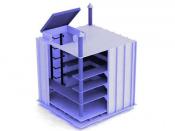Search
Login
Autumn planting of bulbs of flowering plants
In the autumn, new hard work begins, but preparing the site for winter is not limited to harvesting, gathering seeds by pruning trees and other actions. During this period, many plants are also planted - shrubs, trees and flowers. In this article, we will introduce you to the rules for planting flower bulbs.
Content
- What bulb plants are planted in the fall?
- Planting time of onion flowers video
- How to choose a place for plants?
- Soil preparation
- Planting Bulbs - Depth and Width video
- Useful tools
- How to protect bulbs from frost?
- Planting bulb flowers at rock gardens
What bulb flowers are planted in the fall?
Autumn planting of bulbous flowers mainly gives life to plants blooming in spring. Thanks to them, from mid-March, the garden will sparkle with colors even before the awakening of other plants. Bulbous flowers for planting in the fall:
- Tulips
- Hyacinths
- Crocuses
- Daffodils
- Grouse chess
- Imperial crown
- Allium (decorative bow)
- Snowdrop
- Pushkinia (dwarf hyacinth)
- Hionodox (snow beauty)
- Onion Iris (cockerel)
Planting time of onion flowers
The ideal time for planting bulbs is from September to October. Some plants have their own clear dates, for example daffodils, the imperial crown and hazel grouse are planted already in August. In the beginning and mid-September, there is a landing of Pushkinia, hionodox, irises, snowdrops.
Bulbs of tulips and crocuses are planted until mid-October. It is important to finish planting flowers before the first frost, rooting of the bulbs takes several weeks, at this time the soil temperature should not drop below 12 C.
How to choose a place for plants?
All bulbous plants are divided into shade-tolerant and sun-loving. To grow flowers, taking into account their needs, we have prepared a list that will help you choose a place:
Solar bulbs:
- Tulip
- Iris
- Decorative bow
- Hionodox
- Pushkinia
- Crocuses
- Daffodils
- Grouse chess
- Hyacinth
Penumbra:
- Hionodox
- Pushkinia
- Daffodils
- Hyacinth
- Snowdrops
When determining a place for future flowers, pay attention to the previous plants on the site. Do not plant onion flowers where tomatoes, cucumbers, beans and cabbage have grown until then.
Soil preparation
Before the autumn planting of flowers should prepare the soil. Clear the ground of weeds, if necessary, apply herbicides 2-3 weeks before the planned planting date.
The next action is loosening the soil to a depth of about 30 cm. The structure and fertility of the soil is improved by adding compost, manure or peat. Bulbous flowers prefer neutral soil (pH 6.6 - 7.0). If the soil is too acidic, liming will help to bring its value to neutral. Peat acidifies alkaline soil.
Bulb planting depth and width
Planting depth depends on the size of the bulbs. The general rule of depth is three onion heights. For example, if the tulip bulb is 6 cm high, the soil layer above it is 18 cm. The distance between the bulbs varies depending on the height of the plant. The imperial crown and decorative bow are planted with a distance of about 30 cm, the distance between snowdrops is 8 cm.
The intermediate distance of the tulip bulbs is almost 15 cm, this is approximately 40 large bulbs per 1 m2, for small bulbs the value changes upwards - from 60 to 100 per 1 m2. Remember, to protect bulb plants from viral and fungal diseases, they are transplanted to a new place every three years.
Useful tools
Now you can start planting the bulbs. Bulb holes are usually made with a spatula, but there is also a more convenient fixture, which is especially appreciated with a large number of bulbs (from 100 and above). A planter for bulbs, or a planter, is the name for a convenient tool for volumetric work. The bulb planter is made in two versions - a compact planter and planter with a handle. The tool is made of steel, has a scale in cm to adjust the depth of landing.
Flower bulbs can be planted not only in the soil, but also in trellised baskets. This planting method is convenient for further transplantation; bulbs in containers will not be damaged during digging. Also, there is a chance that such a solution will scare away rodents.
How to protect bulbs from frost?
Some plant species are more sensitive to cold than others. As a rule, during frosty winters, bulbs of decorative onions, hyacinths and irises are the first to die. Therefore, they need good protection. For this purpose, after planting onion flowers, the soil is covered with a layer of coniferous branches, bark or peat.
Early mulching will attract rodents, so shelter is carried out no earlier than November. Another advantage of mulch is the delay in soil warming, which will not allow young bulb sprouts to germinate and fall under spring frost.
Covering with leaves is not appropriate here, since they create a dense shell of rot, and the bulbs are susceptible to any fungal diseases.
Planting bulb flowers at rock gardens
Many species of these plants are suitable for rock gardens, but only under the main condition - bulb flowers will grow on the southern side of the site. When ennobling the rock garden, remember the height of the plants and the flowering time. The snowdrop blooms before all; it is recommended to plant it along the edges of the rock garden.
A tall flower, such as iris, is planted on top of a hill. Bulb planting in the rock garden area differs in planting depth, 2-3 cm are added to the usual depth value, this will help to avoid drying out of the plants.





